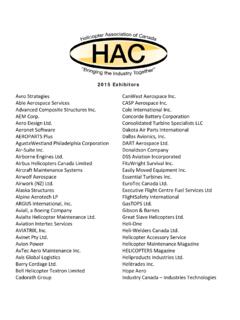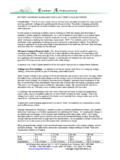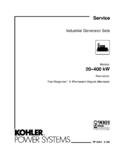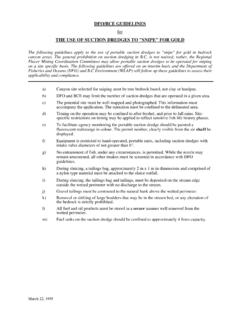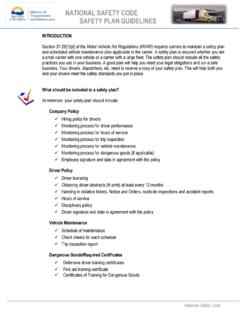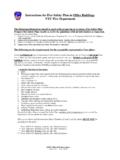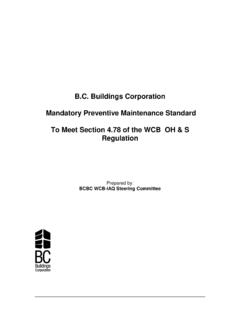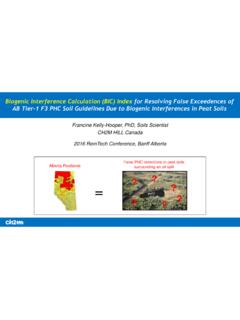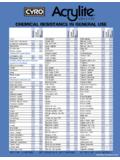Transcription of Oil & Gas Land Exploration Best Practices
1 Oil & Gas Land Exploration Best Practices Oil & Gas Land Exploration Best Practices OGC IBP | Revision Date: Feb 2010 DRAFT. Oil & Gas Land Exploration Best Practices Introduction The intent of the formation of the Helicopter Association of Canada Oil & Gas Committee (OGC) is to help further reduce the accident rate outlined by the IHST, and exposure to risk from members actively involved within the Oil & Gas sector in Canada. It is to be a collective voice, mediator and liaison for the Canadian Helicopter Industry and the Oil &. Gas Industry as it applies to all Oil & Gas land operations. This document has been developed and endorsed by HAC, CAPP and CAGC and was also produced in consultation and with the support of the OGP, but does not fully meet the requirements of OGP 420 (Helicopter Guidelines for Land Seismic and Helirig Operations) For variations with OGP 420 refer to an OGP member aviation adviser.
2 For Example: All Onshore Land Exploration (2010). Pipelines Patrols ( 2011). Offshore Operations ( 2012). Heli-Portable Seismic or Heli-Assist Seismic operations have become a common methodology used for acquiring seismic data in today's helicopter Industry. The technology and Practices in the helicopter industry continues to evolve. This has led to the innovations that improve performance and address safety issues. The purpose of this Best Practice is to establish a minimum guideline for Helicopter supported operations in the Canadian Helicopter industry that will enable companies to operate in a manner that ensures the safety of all personnel and public engaged in these types of operations. This document will be reviewed every three years or if a significant change in regulations or major incident or accident occurs.
3 It will then be updated by the HAC OGC executive and special advisors. This document will identify the following: Standard Safe Operating Procedures and criteria of helicopter operators engaged in Oil and Gas Land Exploration flights. Identification of known hazards and mitigations Federal, Provincial and Territorial regulations pertaining to Helicopter Operations engaged in Land Seismic Operations OGC IBP | Revision Date: Feb 2010 DRAFT. Oil & Gas Land Exploration Best Practices Acknowledgem ents The Helicopter Association of Canada would like to thank the OGP, CAPP and the CAGC for the contributions and participation in the development of HAC OIL & GAS LAND. Exploration BEST Practices document for Canadian Helicopter operators. Acknowledgements for participation on the Oil & Gas committee executive established to prepare this Industry Recommend Best Practice are listed below; the individuals company of employment at the time of contribution is also listed: Executive Committee Members: 1.
4 Robert Gallagher Skyline Helicopters Ltd Exec-Chair 2. Mark Pellow Shell Aircraft International Vice-Chair 3. Corey Taylor VIH Group Vice-Chair 4. Brian Halbert Gemini Helicopters 5. Fred Jones Helicopter Association Of Canada President 6. Grant Louden Helicopter Association Of Canada Board Of Directors Oil & Gas Industry Special Advisors: 1. Doug Iverson Talisman Energy CAPP. 2. Ken Lengyel Petro Canada CAPP. 3. Gary Deren Shell Canada EPW CAPP. 4. Forrest Burkholder CGG Veritas CAGC Vice-chair 5. Marvin Lebeau Geokinetics CAGC HSE Chair 6. Tony Cramp SAI OGP Aviation Sub-committee 7. Eric Crawford CGGV eritas 8. Rene Lavoie Chevron OGC IBP | Revision Date: Feb 2010 DRAFT. Oil & Gas Land Exploration Best Practices DISCLAIMER. The Oil & Gas committee( OGC ) Best Practices document for Helicopter Operators (the IBP ).
5 Provides guidance to members of the Helicopter Association of Canada (HAC) wishing to establish or adopt best Practices for operating in land seismic operations or members from the above mentioned associations who wish to establish similar helicopter operation best Practices . This Guide is not, and is not intended to be, all inclusive. The Guide sets out in general principle recommended Practices for conducting operations in the Oil & Gas Industry, specifically Land seismic. While every effort has been made to supply accurate and up to date information, the OGC, HAC. and their members assume no responsibility for the accuracy, adequacy, or completeness of any information presented in the Guide and assume no responsibility for any errors or omissions, or outcomes resulting directly or indirectly from the use of the Guide.
6 In the event of any conflict, discrepancy, error, or omission between the information presented in this Guide and applicable provincial and/or federal law, regulation, directive, order or recommendation, the provincial and/or federal law, regulation, directive, order or recommendation shall prevail. The members of the OGC and the companies or organizations they represent make no representation, warranty, or guarantee in connection with the publication or the contents of any recommendation, and hereby disclaim liability or responsibility for loss, damage or harm of any kind resulting from the use of this Best Practice or any violation of any legal requirement with which any provision in the IBP may conflict. The information in the IBP is intended as a guide only and does not provide the only acceptable method of dealing with the topics addressed in the IBP.
7 The IBP is not a definitive guide to compliance with government regulation and does not release users of this document from their responsibilities under applicable law, regulation, directive, order or recommendation. The OGC and HAC assume no liability in publishing the IBP. In each case, company or organization personnel should conduct their own due diligence by way of performing specific testing, research, development and implementation of individual methods of controls and should familiarize themselves with all applicable law, regulation, directive order or recommendation. OGC IBP | Revision Date: Feb 2010 DRAFT. Oil & Gas Land Exploration Best Practices Table of Contents GENERAL .. 1. Introduction .. 1. Guidelines for use .. 1. Aircraft operation .. 1. Safety Management Systems (SMS) .. 1. Recommended minimum requirement for SMS.
8 3. RISK ASSESSMENT .. 4. PERSONNEL QUALIFICATIONS, TRAINING AND STAFFING LEVELS .. 5. Flight crew qualifications and experience .. 5. EXTERNAL LOAD .. 5. CLASS D EXTERNAL LOAD .. 6. HOVER EXIT .. 6. CONFINED AREA OPERATIONS .. 6. MOUNTAIN 8. Minimum Engineering 8. Internal training and refresher training by Helicopter Provider .. 9. Flight crew .. 9. Mechanics/Aircraft maintenance 2. Ground crew .. 2. Radio Operators .. 3. Other personnel and visitors on the seismic operations.. 5. Minimum Staffing .. 6. Flight crew .. 6. 8. Ground personnel .. 8. Radio 8. PERSONNEL PROTECTIVE EQUIPMENT .. 8. Recommended PPE for flight crews: .. 8. Recommended PPE for Engineers (AME) and Ground crews:.. 8. HELICOPTER PERFORMANCE AND ROLE EQUIPMENT STANDARDS .. 9. General .. 9. Multi-engine 10. Single-engine 11. Helicopter equipment 11.
9 Helicopter Role equipment maintenance and inspection .. 12. Helicopter Ground equipment .. 12. BASE CAMP GROUND INFRASTRUCTURE AND EQUIPMENT REQUIREMENTS .. 13. Location .. 13. General layout .. 13. Staging's .. 14. Communications and navigation 16. 16. HELI-PADS (LZ) .. 17. Drop Zones .. Error! Bookmark not defined. i OGC IBP | Revision Date: Feb 2010 DRAFT. Oil & Gas Land Exploration Best Practices AVIATION FUEL MANAGEMENT AND FIRE SAFETY .. 18. FLIGHT OPERATIONS SAFETY .. 18. General .. 18. Performance 18. Flight and Duty times for Flight Crews .. 19. Adverse 20. Fuel planning .. 20. Flight 20. PASSENGER TRANSPORT .. 21. LOAD/CARGO TRANSPORT .. 21. External load operation planning factors .. 22. Sling special procedures .. 22. Internal cargo .. 22. Externally attached Cargo/Utility/Ski basket .. 22. Transportation of Hazardous materials.
10 22. EMERGENCY RESPONSE PROCEDURES .. 23. 23. Alternative call out .. 23. Crash 23. THIRD PARTY CONSIDERATIONS .. 24. HETS (HELICOPTER EXTERNAL TRANSPORT SYSTEM) .. 26. Helicopter Class D (Rescue) External 26. MOU (Memorandum of Understanding).. 29. MOUNTAIN FLYING REQUIREMENTS .. 31. Mountain Flying Training 31. ANNEX A RISK ASSESSMENT .. 32. Helicopter Seismic Support Risk Analysis .. 32. Support Specifications .. 33. Operating Conditions .. 34. Aircraft and Crew Details .. 37. Aircraft Performance 38. Consideration Of Single Or Multi Engine Helicopter 40. RISK MATRIX .. 45. USE OF THE MATRIX .. 47. ANNEX B MAINTENANCE AND INSPECTION OF LIFTING EQUIPMENT .. 49. Marking and records: .. 49. Inspection schedule: .. 49. Design and initial testing: .. 49. Proof testing:.. 49. Steel cable, synthetic ( Kevlar, Spectra, Amsteel Blue), or wire rope slings.

